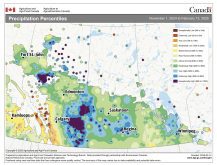Canola fell on news that American soybeans are in ample supply and Brazil’s crop looms large. The United States Department of Agriculture World Agricultural Supply and Demand Estimates for March held few surprises for the market.
Corn was the winner for the day, with nearby futures prices on Chicago rising to match last July’s high point for the year. May’s Chicago Board of Trade corn contract finished the day, March 9, up seven cents to settle at US$3.93 per bushel.
Wheat, however, failed to jump on the cereal bandwagon, with global and American supplies remaining high while corn supplies are relatively low.
Read Also

Flax sector sees omega-3 opportunity
SASKATOON — A global shortage of omega-3 oils could be an opportunity for the flax sector, says an industry official….
In the southern U.S. Plains, winter wheat is coming out of dormancy. No rain is in the forecast to greet most of those plants, but Nebraska and Colorado fields could see some moisture.
Bruce Burnett of Glacier MarketsFarm, a Glacier FarmMedia company that also owns The Western Producer, said the rain will not likely affect wheat fundamentals. The global situation remains bearish, with North American supplies likely to decline due to the drought.
The current forecast from WeatherFarm, also a Glacier FarmMedia business, is for 640 million bushels of hard red winter wheat production, down 110 million bu. from last year.
Record small, planted acreage and drought are expected to pull down 2018 ending stocks in the U.S., but not enough to push prices upward.
The inventory will likely be less than the one billion bu. out there now, but too high for meaningful improvement.
“The lower stocks should provide some price support, but … large international supplies will keep price increases moderate. The wheat market needs another problem area to develop in the coming months in order to sustain higher prices,” said Burnett in his Markets-Insights newsletter on March 12.
USDA put American corn ending stocks at 2.13 billion bu., down from 2.35 billion last month and that put some tiger in the tank. Increased ethanol distilling helped pull the corn inventory down, along with brisk export sales.
Soybean supplies from South America were mixed, with the WASDE report showing heat and drought in Argentina were taking a toll, dropping production by about seven million tonnes. That country’s corn crop is also expected to yield less as a result, putting up three million tonnes less than last season.
Brazil remains the spoiler when it comes to global price and supply, with USDA projecting that crop will rise by one million tonnes and its exports to be another half million on top of that.
Soybeans first fell back and then recovered on the CBOT March contract, coming in a penny higher than it started the day.
Canola is off its recent highs, having been on a good uphill run for more than a month. It finished Winnipeg at the end of last week at C$530.50. March 9, ahead of the USDA report, it tumbled to $521.50 before recovering to $522.20.
USDA boosted its U.S. corn export forecast for the current season by 175 million bu. to 2.25 billion and pushed its projected corn flowing into ethanol to 5.58 billion bu. from 5.53 billion bu.
American soybean ending stocks are estimated to be 25 million bu. higher at 555 million bu. compared to last month’s forecast,.
Wheat inventories in the U.S. rose to 1.034 billion bu. from 1.009 billion, while the USDA projected slightly smaller exports due to high domestic prices and a relatively strong dollar.
American analysts suggest the corn rally might not last for long and weather will control prices.
Farm Futures senior grain market analyst Bryce Knorr said following the release of the monthly report that it contained a few small surprises.
“USDA’s reduction of corn carryout was more than I expected, though the agency’s forecasts of exports and usage are in line with my own,” Knorr said.
“I didn’t expect such a large reduction this quickly because feed usage is still a question mark. Higher prices could trim corn usage in rations, especially with more sorghum likely available. But feed usage changes won’t be worked into the supply and demand table until April, following release of quarterly grain stocks March 30,” he said in a Farm Futures report March 8.














